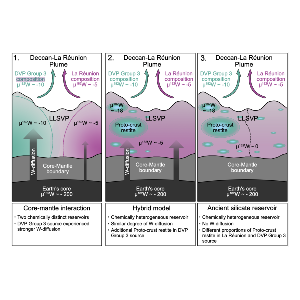Is the Earth’s core leakin?
4 Mar 2025
New publication about isotope compositions of volcanic rocks from the Deccan-La Réunion mantle plume
4 Mar 2025
New publication about isotope compositions of volcanic rocks from the Deccan-La Réunion mantle plume

1) melts originate from different reservoirs, 2) mixed model, 3) melts exclusively from protocrust | © Josua Pakulla
Volcanoes transport lava from the earth's mantle to the earth's surface. This lava solidifies into basalt. Basalts from some ocean islands provide us with information about mantle sources from great depths: Earth's mantle material from near the core-mantle boundary was transported by so-called mantle plumes to depths of 50 to 150 km and melts there. Chemical investigations of these volcanic rocks provide insights into the composition and development of the Earth's deep mantle. To this end, researchers at the University of Cologne are investigating the elemental abundances as well as the isotope compositions. Radioactive isotopes decay into other radiogenic isotopes. For example, half of the isotope 238uranium (238U) decayed to 206lead (206Pb) in around 4.5 billion years (half-life): the proportion of 238uraniumis therefore continuously decreasing, while that of 206leadis increasing. In addition to the 238U-206Pb system, other isotope systems are also used, such as 147Sm-143Nd (samarium-neodymium) and 176Lu-177Hf (lutetium-hafnium).
Isotope systems and earth mantle processes
Isotope systems are traditionally used to date rocks. However, whether a rock or an area in the Earth's mantle has a lot of 147Sm, 176Lu, and 238U and therefore 143Nd, 177Hf, and 206Pb over the course of time also depends on different geological processes. The melting of the earth's mantle, the slow crystallization of lava in the earth's crust or the mixing of different lavas redistribute the isotopic proportions. The isotopic composition of a rock is therefore characteristic of different processes in the Earth's mantle and crust, allowing conclusions to be drawn about the composition of the Earth's mantle over geological time periods. For example, researchers can investigate whether continental or oceanic crust has been recycled into the deeper earth.
Earth crust recycling and core-mantle interactions
Josua Pakulla and Niklas Kallnik, two doctoral students in Prof. Carsten Münker's research group, used the isotope systems 182Hf-182Wand 146Sm-142Ndwith relatively short half-lives: around 9 million(182Hf-182W) and 100 million years(146Sm-142Nd). As a result, 182Hf has completely decayed to 182W after about 60 million years and after about 500 million years there is hardly any detectable 146Sm left. As a result, these isotope systems only provide information about the period shortly after the formation of the Earth. Processes that can influence these isotope systems in the first 60 and 500 million years are, for example, the formation of the Earth's core, the differentiation of the Earth's mantle, or the formation of the Earth's first crust in the Hadean age (>4.0 Ga). Earlier studies of the tungsten isotope 182W showed that this isotope is less abundant in some ocean island basalts than in other volcanic rocks. It was hypothesized that tungsten from the 182W-poorer Earth's core entered the lower mantle and was then brought to the Earth's surface in a mantle plume. However, Josua and Niklas' new measurements of various isotopes such as 142Nd, 182W, and 206Pb on samples from the Deccan-La Réunion mantle plume and Iceland suggest that recycled old crust from the time shortly after the formation of the Earth (Hadean) may also be a reason for the 182W deficits. It is likely that the different 182W isotopes in mantle plumes are influenced by different processes: some by core-mantle interaction and others by hadaic rocks recycled into the deep mantle.
Link to the publication:
Pakulla, J.J., Tusch, J., Hasenstab-Dübeler, E., Ravindran, A., Jansen, M.W., Leitzke, F.P., Gadpallu, P., Duraiswami, R.A., Münker, C.(2025). The spatio-temporal evolution of 182W and 142Nd in the Deccan-La Réunion plume. Earth and Planetary Science Letters, 653.https://doi.org/10.1016/j.epsl.2025.119225